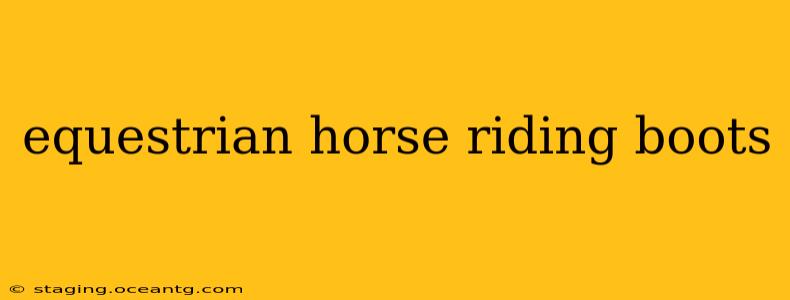Choosing the right pair of equestrian boots is crucial for both comfort and safety. Whether you're a seasoned professional or just starting your riding journey, understanding the different types, features, and considerations will help you find the perfect fit. This guide delves into the world of equestrian horse riding boots, answering frequently asked questions and offering expert advice to ensure you make an informed decision.
What are the different types of equestrian riding boots?
Equestrian boots fall into several categories, each designed for specific disciplines and riding styles:
-
Field Boots: These are the most common type, typically made from leather and reaching just below the knee. They offer a balance of comfort, durability, and support, making them suitable for general riding and many disciplines. They often feature a slightly higher heel to aid in maintaining proper posture in the stirrup.
-
Paddock Boots: Shorter than field boots, these boots offer ankle support and protection but are less formal. Ideal for everyday stable work or less formal riding activities. They are often more affordable than field boots.
-
Tall Boots: Reaching above the knee, tall boots are often preferred for disciplines like dressage and jumping. They offer excellent support and a more polished appearance. They can be made from leather or other materials and come in various styles and heights.
-
Jodhpur Boots: These ankle-high boots are typically worn with jodhpurs (breeches that are tight-fitting around the ankle). They provide ankle support and are suitable for less formal riding or stable work.
What features should I look for in equestrian riding boots?
Several key features contribute to the quality and comfort of equestrian riding boots:
-
Material: Leather is a popular choice for its durability, breathability, and ability to mold to your foot over time. However, synthetic materials offer more affordable options.
-
Sole: A good quality sole provides grip and stability, whether you're in the saddle or on the ground. Look for soles with good traction and durability.
-
Heel: A slightly raised heel is essential for proper riding posture, helping you maintain your balance and connection with the horse.
-
Zipper/Laces: Boots with zippers offer ease of use, while laces provide a more customized fit. Consider your personal preference and the level of adjustability you need.
-
Fit: Proper fit is paramount. Boots that are too tight can restrict blood flow and cause discomfort, while boots that are too loose can be unsafe.
How do I choose the right size and fit for my equestrian riding boots?
Finding the right fit is crucial for both comfort and safety. Here's what to consider:
-
Measure your feet: Measure your feet at the end of the day, when they are slightly swollen, to ensure a comfortable fit.
-
Try them on: Always try boots on before purchasing them. Walk around in them to assess comfort and ensure there's enough room for your toes.
-
Consider sock thickness: Think about the thickness of the socks you'll wear with the boots.
-
Professional fitting: If possible, get your boots fitted by a professional at an equestrian store. They can help you find the perfect fit and recommend suitable styles.
How do I care for my equestrian riding boots?
Proper care will extend the life of your equestrian boots:
-
Regular cleaning: Use a leather cleaner and conditioner regularly to maintain the leather's suppleness and prevent cracking.
-
Protection: Use a protective spray to shield your boots from water and dirt.
-
Storage: Store your boots in a cool, dry place away from direct sunlight to prevent damage.
Are there specific boots for different riding disciplines?
Yes, the choice of boot can often depend on the discipline. While field boots are versatile, certain disciplines might favor specific types:
-
Dressage: Often favors tall boots for a more elegant and polished look.
-
Jumping: Tall boots offer more ankle support for the demands of jumping.
-
Western Riding: Western boots have a distinctly different style and design, featuring a higher heel and often more elaborate stitching.
By carefully considering the different types, features, and fitting considerations, you can choose the perfect pair of equestrian riding boots to enhance your riding experience and ensure your safety and comfort in the saddle. Remember, investing in quality boots is an investment in your riding journey.
